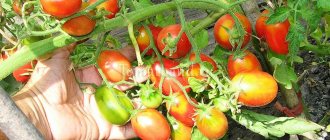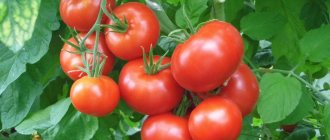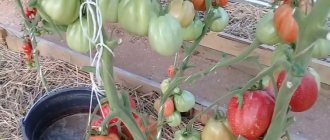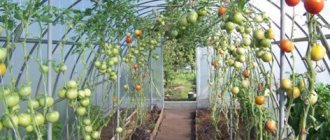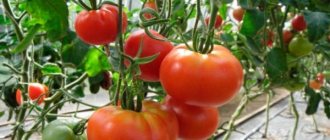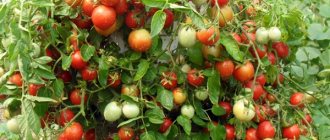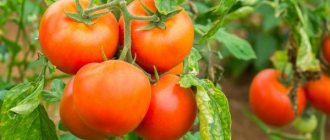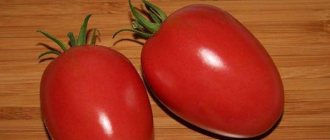Description of the variety
The Sugar Nastasya tomato was developed by breeders at the beginning of this century, and in 2013, specialists from the agricultural company LLC Selection Firm Gavrish presented the variety for inclusion in the Russian State Register. And after the tests, a couple of years later, the Sugar Nastasya tomato was included in the State Register of Agricultural Achievements of Russia.
The Sugar Nastasya tomato is recommended for growing in greenhouse conditions in all Russian regions, but it grows well in areas with a temperate and warm climate in garden beds.
Features of bushes
The Sugar Nastasya tomato is a mid-season variety - up to 130 days pass from the moment of seed germination to the harvesting of ripe tomatoes.
The bushes of this tomato are indeterminate and medium-sized. In open ground conditions, shoots can reach a height of 1.5 m, and in film greenhouses - up to 1.7 m.
The bushes are strong, powerful, slightly spreading, with medium branching. The shoots are erect and strong, but they can bend and break under the weight of ripening fruits, so they must be tied to strong stakes or trellises as they grow.
The foliage is of the usual tomato type, narrow, elongated, with sharp tips, rich emerald color.
The flowers are small, yellow, collected in racemes. Up to 9 ovaries are formed in each brush. The first brush is formed under 6-7 true leaves, and each subsequent brush is formed after a couple of sheets.
Features of the fruit
Based on the size of the fruit, the Sugar Nastasya tomato belongs to beef tomatoes, that is, varieties with large, fleshy fruits.
Ripe tomatoes are large in size, heart-shaped with raspberry-colored skin. The peel is smooth, even, thin, with a characteristic shine. The stalk has a slight ribbing. The pulp is sugary, fleshy, sweet, and its taste also contains fruity notes. The aroma is rich, tomato.
The weight of one fruit reaches 350-400 g. But if vegetable growers want to get larger fruits, then they form the bush into one shoot and remove some of the flowers in the racemes. Then the weight of the tomatoes can approach 700-800 g.
The pulp contains several seed chambers with an average amount of seed material.
The fruits tolerate transportation well over different distances, but are not stored for long.
Distinctive features
The distinctive features of the Sugar Nastasya tomato include:
- original heart-shaped fruit;
- large fruit;
- tomato belongs to the salad variety;
- The pulp is sugary and has a pleasant sweet taste.
Similar varieties
There are other varieties of tomatoes with large heart-shaped fruits, but almost all of them have red rather than raspberry color. These are beef tomatoes such as:
- Maiden's heart - tomato fruits are large, about 500-600 g, with a pinkish-red skin color.
- Purple Heart - with heart-shaped fruits, purple-violet color and fleshy sweet pulp. The average weight of tomatoes is about 300 g.
- Bull's heart is the most famous large-fruited tomato with heart-shaped fruits. The color of the skin is reddish-pink, the average weight of the fruit can be up to 700-800 g.
Tomato Sugar Nastasya: reviews from summer residents
As already mentioned, gardeners have a very good opinion about tomatoes of this variety. Gardeners consider the main advantage of Sugar Nastasya, of course, to be the excellent taste of the fruit. Summer residents also consider unpretentiousness to be an undoubted advantage of tomatoes of this variety. Tomatoes Sakharnaya Nastasya get sick, judging by the reviews available on the Internet, extremely rarely. The immunity of this variety, as some gardeners note, is simply impenetrable.
Characteristics of the variety
This tomato variety can be grown in greenhouse conditions, film greenhouses, and in garden beds almost throughout Russia. But the Sugar Nastasya tomato was bred specifically for planting in greenhouses and film greenhouses.
During the growth period, a tomato of this variety calmly tolerates periods of drought, as well as short-term drops in temperature; it is important that such stressful situations do not drag on.
Advantages and disadvantages
Of the main positive qualities of the Sugar Nastasya tomato, it should be noted:
- good tomato yield - up to 5 kg of fruit from each bush;
- the fruits are of good quality, up to 95% of the harvested crop has an excellent presentation, so the harvested tomatoes can be sold on the market;
- This tomato is unpretentious and easily tolerates short-term heat and decreased temperatures during the growth period;
- the variety is resistant to most diseases characteristic of other types of tomatoes;
- The harvested crop tolerates transportation well over different distances. Vegetable growers have different opinions regarding keeping quality - some talk about the long shelf life of fruits in appropriate conditions, while others note that harvested tomatoes cannot be stored for a long time.
Among the disadvantages of tomato it should be noted:
- In order for the fruits to grow large, it is necessary to regularly fertilize the tomato bushes;
- tall shoots require mandatory garter;
- In order to get a high-quality harvest, it is necessary to correctly form the bushes, which requires a certain dexterity and skill.
Productivity
Fruiting of this tomato occurs between July and August. When grown in greenhouses, up to 11 kg of ripe fruits can be collected from each square of area. When grown in garden beds, the yield will be slightly lower. However, the taste and presentation of the fruit will be the same when growing tomatoes in open and closed ground.
And from each bush you can collect up to 5 kg of ripe tomatoes.
To increase the yield of the Sugar Nastasya tomato, it is recommended to plant the plants in 1 shoot and normalize the number of ovaries in the clusters, removing several flowers from each. In this case, the fruits will grow larger.
Area of application of fruits
The fruits of this tomato are versatile - thanks to their sweet, almost honey-like taste, ripe tomatoes are mainly consumed fresh. They are added to salads, snacks, and hot dishes. They also make delicious thick tomato juice, tomato paste and ketchup, which are closed for the winter. And only for whole-fruit canning, large tomato fruits Sugar Nastasya are not suitable, since they simply do not fit in jars.
Disease resistance
When bushes of this variety have one or two shoots, their resistance to diseases will be high. Tomato Sugar Nastasya is practically not affected by fungal diseases, phytosporosis, fusarium, and brown spot.
Advantages and disadvantages of the variety
Culture has many positive qualities:
- possibility of breeding in all regions;
- high fruiting rate;
- unpretentious care;
- resistance to tomato diseases;
- formation of numerous ovaries;
- excellent sweet taste;
- large fruits;
- unusual shape;
- the ability to independently collect seeds for planting.
Negative properties include:
- obligatory garter;
- the need for formation and stepsoning;
- short storage;
- impossibility of transportation.
We grow seedlings
Sugar Nastasya tomato should only be grown using seedlings. In this case, seed material for seedlings is planted approximately 55-60 days before the planned transplantation of plants to a permanent place in a greenhouse or garden beds.
Seed preparation
It is recommended to purchase seed material of this tomato in specialized stores from the originator of the variety - the Gavrish seed company. Such seeds do not require any preparation before sowing as seedlings, but it is advisable to soak them in a growth accelerator solution so that they germinate faster.
You can collect your own seed material from this tomato, which is used by many summer residents. But such seeds will have to be prepared before planting. First, they are placed in salted water to remove empty planting material - it usually floats to the surface. Then you need to disinfect the seeds - place them for half an hour in a weak solution of potassium permanganate. After this, they are washed, soaked in a growth accelerator and planted in prepared containers.
Container and soil
Containers must also be disinfected before planting seeds - they are treated with hydrogen peroxide or a pink solution of potassium permanganate. Each container must have drainage holes through which excess moisture will drain out after watering.
To plant tomato seeds for seedlings, you should purchase a special nutrient substrate from a gardening store - this should be soil for growing seedlings of vegetable plants.
If summer residents decide to prepare such soil on their own, then in the fall they must prepare all the necessary components - turf, high peat, humus, as well as river sand and sawdust, which are necessary to give the soil mixture the necessary looseness.
In the spring, all components are mixed in equal quantities, 500 g of sand and sawdust are added for every 10 kg of this mixture, mixed again and steamed in a water bath to disinfect the resulting nutrient substrate.
After this, the mixture is ready to be placed into containers.
Sowing
Seed material for seedlings should be planted from the second ten days of February to the last ten days of March, depending on the location (indoor and open ground) and climatic conditions of the growing area.
Seed material is laid out in rows on the soil surface. The distance between such rows should be at least 2.5 cm. The seed material is covered with a thin layer of soil on top and sprayed with a spray bottle.
To make the seed material germinate faster, the containers need to be covered with glass to create a greenhouse effect inside. The temperature in the room where the containers with the sown seeds will be placed should be at least +25০С.
After sprouts appear in the containers, the glass is removed and the plants are transferred to a bright place.
We must remember! The height of the emerging sprout to the cotyledon leaves is 4-5 cm, this height is typical for indeterminate varieties of tomatoes.
Seedling care
After friendly shoots have appeared in the containers, they should be hardened off. To do this, the room temperature is lowered to +17+18ᴼC for several days. Then it can be raised again to 23ᴼC.
Plants are watered regularly, moderately. The next watering is done when the top layer of soil has dried. Water for irrigation is pre-settled and heated. The sprouts should be watered carefully at the root, while droplets of moisture should not fall on the stems and leaves, and the stream of water should not erode the soil near the plant.
Important! Moisture should not stagnate in the containers - this can lead to the development of root rot, from which the seedlings are unlikely to be saved.
It is also important to provide tomato seedlings with full daylight. It must be at least 12 hours. If there is not enough natural light, or in cloudy weather, the seedlings should be supplemented with light. To do this, install fluorescent lamps or phytolamps next to the plants.
When the seedlings have their first true leaves, they are planted in separate containers. It is important to replant only strong, strong plants, because weak seedlings will not catch up in growth with healthy seedlings over the entire growing period.
Important! The composition of the soil in containers for replanting should be the same as in the main containers and be as close as possible to the soil in which the plants will be grown in their permanent place.
During the growing of seedlings, they are fed with nitrogen-containing fertilizers twice: the first time - 12-14 days after picking, and the second time - 2 weeks after the first feeding, but no later than a couple of weeks before transplanting into a greenhouse or garden beds.
12-14 days before planting the seedlings in a permanent place, they need to begin to be hardened off by taking them out into the fresh air. In the first days, the time in the air for plants should be no more than an hour, but then it gradually increases.
By the time of transplantation, adult seedlings should have at least 5 permanent leaves, a thick, strong stem and a developed root system.
Features of cultivation and storage
3-5 bushes are planted per 1 m2. The plantings are not thickened.
The beds are arranged in fertile soil. Fertilizers are preliminarily applied:
- 1 bucket of compost;
- 20 g superphosphate;
- 5 g potassium sulfate;
- 1 cup wood ash.
The calculation is given for 1m2. Water moderately, trying not to over-moisten the soil.
The formation is carried out in 1-2 shoots. The trunks are strengthened to the trellises.
What are the features of fertilizer? Important fertilizing is carried out during flowering, setting, and ripening. Of the complex drugs used:
- "Kemira";
- "Agricola";
- "Strong."
A good effect is achieved by watering with a diluted solution of manure or mullein, which is infused for 5 days. Then dilute 1:10 and apply root feeding. Valuable mineral compounds for tomatoes:
- superphosphate;
- potassium sulfate;
- wood ash;
- saltpeter
Tomatoes are stored for 1 month. Lay them in 1 layer. The rooms are chosen dark, cool, but without drafts.
Growing tomatoes
When transplanting seedlings to a permanent place in a greenhouse or garden beds, it is very important to create comfortable conditions for them in a permanent place - increase the fertility of the soil, dig it up to make it looser, etc. Only in this case will strong seedlings quickly take root in a new place, quickly grow and produce a good harvest in the future.
Planting in a greenhouse
The greenhouse needs to be prepared in the fall for growing Sugar Nastasya tomatoes in it. After harvesting you need:
- disinfect all greenhouse structures;
- remove all vegetation from the soil;
- replace the top layer of soil in the beds with fresh, nutritious soil;
- if it was not possible to replace the soil, then you need to disinfect it with a solution of potassium permanganate;
- then 6-7 kg of humus is added to the soil for each square of area and the soil is dug up, incorporating organic matter into it;
- in the spring, planting holes are dug according to a 40*60 cm pattern, at the bottom of which a handful of superphosphate and the same amount of ash are laid out.
Transplanting seedlings is done as follows: transfer the plant into the hole along with a lump of earth, fill the hole with soil, compact it and water it.
Bedding
To plant this variety of tomato, choose a sunny area, protected from gusts of wind. In this case, you need to follow the rules of crop rotation and not plant tomatoes where other plants from the nightshade family grew the previous year.
The soil in the garden bed is fertilized and dug up in the fall; in the spring, the area is loosened and planting holes are prepared in a checkerboard pattern.
Tomato seedlings Sugar Nastasya are transplanted into garden beds in the same way as in a greenhouse.
Features of care and possible difficulties
This variety of tomato grows large, so it requires a lot of space in beds and greenhouses. And when growing in a greenhouse, the height of the shoots must be taken into account, so the height of the structures must be appropriate.
In order for large fruits to ripen on the bushes of this variety, you need to properly form the plants, apply regular fertilizing and follow the watering regime.
When growing in a greenhouse, it is important to monitor the humidity level and ventilate it daily, especially after watering. If the humidity is not monitored, then a tomato of this variety can be damaged by fungal diseases.
Transplanting
Seeds of this variety are usually sown in boxes in early March. In this case, the planting material is pre-treated with potassium permanganate. Seedlings are planted in rows with a step of 2 cm and a distance between individual holes of 1.5 cm. The seeds are buried 1 cm.
Subsequently, seedlings are cared for using conventional technology. That is, it is periodically watered and weeded. It is recommended to plant Sugar Nastasya seeds in fertilized soil. Plants of this variety usually develop actively, and therefore they require quite a lot of nutrients.
Care
Further care for the Sugar Nastasya tomato consists of timely watering, fertilizing, loosening the soil, forming bushes and tying up shoots.
Formation
The formation of bushes of this tomato is carried out in one or two stems. In the first case, only the central stem is left, and all the stepsons are removed. In the second case, a stepson is left, which is formed under the first flower cluster - a side shoot will grow from it, all other stepsons are also broken off.
Feeding
In order for large fruits to ripen actively on the bushes, they require a lot of nutrients. To do this, once every 30 days, a complete complex mineral fertilizer is applied to the root zone of the bushes.
Watering and loosening
Water the bushes of this tomato 2-3 times a week, moistening the soil to 40 cm. To make the moisture evaporate more slowly, the root zone is mulched with straw or green grass.
After each watering, it is recommended to loosen the soil so that oxygen reaches the roots of the tomatoes. At the same time, weeds need to be removed along with their roots.
Stepsoning
The stepsons on this tomato are removed as they appear; in the case of growing a tomato bush with 2 shoots, only one lower stepson is left.
Mulching
Mulching the root zone of tomato bushes allows you to retain moisture in the soil longer. Also, a layer of mulch prevents the growth of weeds, which choose food from the soil and can be a place where harmful insects settle.
Securing the stem
Since the shoots of the Sugar Nastasya tomato are quite tall and the fruits are heavy, it is recommended to tie them to strong stakes or trellises in several places. This is done so that heavy tomatoes do not break the stems on which they grow.
The garter is carried out with a silk thread, which will not damage the shoots.
Planting dates and care
Sugar Nastasya is planted in a film greenhouse when the soil outside warms up to 10° C, at 50-55 days of age. You should add a week for seed pecking, and you can independently calculate the sowing time, focusing on the climate and long-term weather forecast.
Sowing seeds
Seeds coated or otherwise processed are planted without prior preparation, dry. With ordinary ones, the following mandatory procedures are carried out before planting:
- warming up;
- disinfection;
- soaking until swelling.
Other operations are optional. The variety has good germination, if gardeners are confident in the quality, there is no need for hardening, germination, or stimulation.
The manufacturer claims that with proper maintenance, the seeds of this tomato remain viable for 10 years. After the expiration date, they are not thrown away, but the sowing rate is increased. Although why is not clear, because planting material can be collected independently.
The seeds are planted to a depth of 1-1.5 cm, spread out every 1-2 cm. The distance between the rows is 4 cm. Moisten with a spray bottle and cover with film or glass. Keep at 25° until pipping.
Growing and planting seedlings
As soon as the seeds sprout, the containers are transferred to a cool room and illuminated with phytolamps so that the subcotyledon does not stretch. After a week, the temperature is raised to 20-22° C. Lighting is reduced to 12-14 hours a day.
In the phase of 1-2 true leaves, they dive. After 14 days, they begin to feed with a mineral complex with a high nitrogen content.
2 weeks before moving to a permanent place they are hardened. The planting pattern recommended by the breeder is 40x60 cm.
Further care
Like all large-fruited tomatoes, Sugar Nastasya requires more water and minerals than varieties with small or medium-sized tomatoes.
After the second brush is extended, the plant is transferred from the vegetative to the generative stage of development. In fertilizing, nitrogen is reduced and doses of potassium, phosphorus, and microelements are increased. But special attention is paid to calcium - it prevents blossom end rot from appearing on tomatoes.
Ca is given 1-3 days earlier than K. The ratio of elements should be 7:10, respectively. Otherwise, potassium blocks the absorption of calcium, even if there is enough of it in the soil.
We must not forget about nitrogen. The amount of N in fertilizing is reduced, but not completely eliminated - the element is needed to maintain the leaf apparatus, which is responsible for the supply of plastic substances to the fruit.
Watering is done regularly, but not abundantly. The soil should not be alternately waterlogged and dry out - this will cause large tomatoes to crack, reducing their marketability.
Sugar Nastasya is tied to a strong support, the leaves under the brush that has begun to fill, and all lateral shoots are promptly removed. Lead into 1 trunk to obtain large fruits. If you need a lot of smaller tomatoes, leave 2, 3, or even 4 stepsons. The more fruiting shoots there are on the plant, the smaller the tomatoes will grow.
It is recommended to mulch the soil with straw, non-woven material or mowed grass. This greatly simplifies maintenance - it protects the soil from drying out, overheating, and weed germination.
Nuances when growing in a greenhouse and open ground
The greenhouse in which the bushes of this tomato will grow must be quite high and spacious, since the Sugar Nastasya tomato requires a lot of space. It is also important to monitor the humidity level in closed ground and lighting. Humidity levels can be controlled by regularly ventilating the greenhouse, and lamps can be installed as additional lighting.
When grown in open ground, the shoots of this tomato are tied to strong supports, bushes are formed into two shoots, and do not forget to regularly apply fertilizer.
Farmer reviews
Tomato fruits are so beautiful when ripe that many gardeners plant the variety on their plots after seeing photographs. The taste characteristics are no less impressive than the appearance of ripe vegetables:
Olga, Syzran: “I really like large tomatoes so that salads can be prepared fresh. I call my favorite variety nothing other than the Sugar Nastya tomato. The tomatoes are really sugary and very flavorful. I always pick off excess leaves, so my seedlings don’t get sick.”
Evgeniy, Ryazan: “I am an experienced summer resident, I have tried many varieties. Now it’s Sugar Nastenka’s turn. I have a large garden, so the size of the bushes doesn’t bother me. The tomatoes grew very beautiful: large, pink, sweet. But for this you need to regularly feed and water. However, like any other culture.”
Diseases and pests
Experts note that the Sugar Nastasya tomato is highly resistant to most diseases that are characteristic of other tomato varieties. Also, harmful insects almost never attack the bushes of this tomato.
Pest and disease control
Since the bushes of this tomato are practically disease-free, vegetable growers do not have to fight diseases and pests.
Preventative treatment
But it is still important to carry out some preventive measures to prevent the development of diseases and pest attacks on the Sugar Nastasya tomato:
- periodically inspect tomato bushes in order to notice symptoms of disease or the appearance of harmful insects in time;
- observe the irrigation regime and control soil moisture;
- remove all weeds along with roots;
- regularly loosen the soil and mulch the root zone%
- Ventilate greenhouses regularly.
When transplanting, it is recommended to spray the seedlings with a solution of potassium permanganate, and spill the soil with a solution of copper sulfate.
Disease resistance
The registration commission did not provide information on the variety's resistance to diseases.
Regular inspection of bushes will help to promptly identify pests and pathogens and prevent an increase in pathogenic enemies.
Perhaps a little time will pass and reviews from vegetable growers will tell how resistant the variety is to diseases and pests, but for now it is necessary to carry out treatments with fungicidal preparations regularly and in a timely manner.
The first treatment is carried out as soon as the tomato ovary is the size of a small nut, and then after 15-20 days, depending on the situation.
Photo
Pros and cons of the variety
| Advantages | Flaws |
| High taste qualities. | Late ripening. |
| The fruits ripen quite large. | If not properly cared for, the crop is susceptible to blossom end rot. |
| High yield in any conditions. | To get a good harvest, you need to do the shaping correctly. |
| Fleshy tomato pulp. | The crop needs to be tied up, as due to the high altitude and impressive harvest, the bushes can break. |
| A small amount of seeds. | If you do not apply fertilizers and fertilizing, there can be no talk of any harvest. |
| Suitable for growing both in open ground and in greenhouses. | |
| Planting material remains viable for 10 years. | |
| Seeds obtained from your own harvest can be used for cultivation. |
Reviews
Yulia, 40 years old, Ivanovo: last year we decided to plant some new variety of tomato with large fruits. We decided on the Sugar Nastasya tomato. I really liked the taste of the fruit – sweet, with a slight sourness. The harvest was used exclusively for food - they prepared salads and snacks, fried and stewed. But in my opinion, the fruits of this variety are not suitable for preparing food for the winter.
Alexander, 59 years old, Tver: every year in my garden, in addition to the usual varieties of tomatoes, I plant some new ones. Last year it was the Sugar Nastasya tomato. I was pleased with the yield of this variety - the bushes were hung with bunches of fairly large tomatoes. True, they were smaller in mass than indicated in the description, but still large enough - a couple of fruits, and the salad is ready. Then I realized that in order to obtain large fruits it was necessary to remove part of the ovaries in the clusters, and also to form bushes of no more than two stems. Next season I will do the same - I want to see how large the fruits of this tomato can grow.
Although this tomato variety is quite new, it is already popular among Russian vegetable growers who grow beef tomato varieties in their gardens. The Sugar Nastasya tomato is a salad variety due to the pleasant taste of the fruit, so most vegetable growers grow it exclusively for eating fresh tomatoes.
Advantages of the variety
New variety. Few people have yet been able to appreciate its merits, especially since it is not clear what is packaged under its name. However, having become the owner of seeds of the “Sugar Nastasya” variety, vegetable growers will enjoy its qualities:
- large-fruited;
- interesting flat shape;
- excellent taste;
- good yield.
It is difficult to talk about the shortcomings of the young variety. It won’t be long before vegetable growers share their impressions in full.
Growing seedlings
It is grown by seedlings; the seeds are sown closer to the beginning of spring. Before planting, it is advisable to disinfect them by holding them in manganese for about 30 minutes and then rinsing them well. The soil is prepared in advance; during the winter it is better to harden it, then take it out into the cold, then bring it into the heat.
The depth of the grooves for seeds should not exceed two centimeters, otherwise it will be more difficult for the sprouts to hatch. After sowing, watering is required, preferably with water at a temperature of 20 degrees. Then the containers with seedlings are covered and placed in a warm place; when sprouts appear on the surface of the soil, the film is removed. Seedlings love light and warmth; if the place is not sufficiently lit, they may stretch out and become unsuitable for planting. The room temperature should be at least 20 degrees. The appearance of a pair of true leaves indicates the plant is ready for picking. During this period, you can feed it with a weak solution of complex mineral fertilizers.
Once every five days, seedlings need watering, this can be done using a sprayer. They begin to harden off about two weeks before transplantation; this will help the young plant adapt more quickly to its new location.
Landing
“Sugar Nastasya” is part of the group of late-ripening varieties that require at least two months to grow seedlings. The best sowing month for seedlings is March or February. It is not recommended to sow earlier. Overgrown seedlings do not adapt well to garden beds.
To get good seedlings, you must follow the given sequence of work.
- Disinfect seeds in a weak manganese solution.
- Treat the seeds in a growth stimulator and spread between layers of damp cloth. Wait until small sprouts appear (hatch).
- Prepare loose soil. It must include turf, humus, sawdust or sand, and ash in the proportion of one tablespoon of ash per bucket of earth.
- Disinfect boxes or pots, fill with prepared soil, spread the seeds in an even layer and sprinkle with a 1 cm high layer of soil.
- Water well and cover with film. Watering should not be abundant.
- As soon as the first shoots appear, you need to remove the film and place the pots in a well-lit place. For good seedling growth, 12 hours of lighting is required at a temperature of +22-24 C.
After two true leaves appear, the seedlings need to be pricked. To do this, choose only healthy and strong seedlings. Weak sprouts will lag behind in their development and will not have time to bear full fruit.
Bedding
You can plant seedlings in a greenhouse or open ground after 55-60 days. The temperature of the ground should not be lower than + 10 C. If by the time of transplanting into the ground tassels have begun to form on the tomatoes, then do not worry. This is not dangerous for transplantation; the seedlings will take root well.
“Sugar Nastasya” is planted in greenhouses at the beginning of May, under film at the end of May, and at the beginning of June in open ground. It is necessary to plant carefully so as not to destroy the earthen lump and damage the root system.
The prepared hole is watered abundantly, a ball of seedlings is placed in it, covered with pre-prepared nutrient soil, compacted a little and watered again. Water should not get into the green areas of the plant.
Best reviews from our readers
- Valentina
I planted it for the first time this year, 2022. It led into two trunks. They were the first to start singing, the fruits were plentiful and tasty. But., because. I grow them according to Galina Kizima’s method (without watering at all), the tomatoes have suffered a little blossom end rot. However, like all elongated ones).
- Marina
One of the best varieties of tomatoes. Fleshy, large, beautiful and very productive. In 2022, I planted only 2 bushes as a test. This will be my main tomato variety in the new year!
- Faith
Summer 2022 – sultry June, and in July, if not rain, then downpour. Nastasya endured everything and did not get sick. The pulp is sugary, I didn’t notice any sourness. Excellent variety, I’ll leave it for seeds!
- Zhanna Birkova
those that were the first to ripen were sour... and I tried them from this batch today, they were really sweet... when cut! Meaty and delicious!
- Zhanna Birkova
I liked the variety, the taste is excellent, but I have a slight sourness... I think in more capable hands it will open up better.... The bush is powerful, it was one of the first to bloom, it began to sing first, the bush is powerful, 150 cm in height. There are... those that grew in one trunk produced large fruits, in two or three trunks there were smaller ones, but in a cluster there were 5-8 pieces each. So basically the variety corresponds to the declared one. In the 1st photo Sugar Nastasya is in the OG and in the 2nd photo in the greenhouse
TomatLand14 094 views10 reviews Rating from those who grew it: 3.34 out of 5
You can buy tomato seeds “Sugar Nastasya” from the seller
